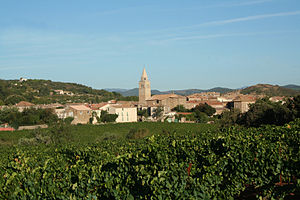Gabian
| Gabian | ||
|---|---|---|

|
|
|
| region | Occitania | |
| Department | Herault | |
| Arrondissement | Beziers | |
| Canton | Cazouls-lès-Beziers | |
| Community association | Les Avant-Monts | |
| Coordinates | 43 ° 28 ' N , 3 ° 13' E | |
| height | 82-260 m | |
| surface | 15.96 km 2 | |
| Residents | 841 (January 1, 2017) | |
| Population density | 53 inhabitants / km 2 | |
| Post Code | 34320 | |
| INSEE code | 34109 | |
| Website | Gabian | |
 Gabian - town view |
||
Gabian ( identical in Occitan ) is a town in the south of France and a municipality with 703 inhabitants (as of January 1, 2017) in the Hérault department in the Occitania region . The place counts itself to the round villages ( circulades ) of the Languedoc.
location
The place Gabian lies at an altitude of approx. 120 m above sea level. d. About 25 km (driving distance) north of the city of Béziers on the river Thongue .
Population development
| year | 1800 | 1851 | 1901 | 1954 | 1975 | 1999 | 2012 | 2017 |
| Residents | 827 | 1,044 | 1.103 | 784 | 743 | 659 | 827 | 703 |
In the middle to the end of the 19th century the place had more than 1300 inhabitants at times; The phylloxera crisis in viticulture and the increasing mechanization of agriculture then caused a significant population decline.
economy
For centuries, the inhabitants of Gabian lived on a self-sufficient basis from agriculture, which also included viticulture and a little cattle breeding. The wine produced in the municipality today is marketed through the Languedoc , Pays d'Hérault and Pays d'Oc appellations. Already in the Middle Ages, but especially since the 17th century, some of the town's residents worked in a nearby petroleum spring . Since the middle of the 20th century, tourism has also played a certain role in the town's income in the form of renting out holiday homes ( gîtes ).
history
Already in Roman times a water pipe connected several springs in the area of Gabian with the Colonia Urbs Julia Septimanorum Baeterra , today's Béziers . In addition, the Romans discovered a nearby petroleum spring , which was forgotten after their departure and was only rediscovered in 1067 by monks from Carcassonne , who settled in the ruins of an old Roman villa ( Villa Cassianus ). In 1080 Pope Gregory VII confirmed the establishment of a priory, which later became the Cassan Abbey , which is now in the neighboring parish of Roujan . Since 1115 a summer residence of the Bishops of Béziers was built in Gabian . At the beginning of the 13th century the place and the petroleum springs were taken by the Cathars . King Henry IV advocated the use of kerosene for street lighting at night ; it was also classified as a medicinal product by the University of Montpellier in 1605 . The doctor Guillaume Rivière wrote a detailed scientific description of Gabian's stone oil as early as 1717. From 1876 it was transported by rail to northern France; From 1882 it was refined to be usable for internal combustion engines . 1950 marked the end of the economic use of Gabian kerosene.
Attractions
- The remains of the Roman aqueduct are not very impressive, but the aqueduct was placed under protection as a monument historique in 1993 .
- Nothing is left of the medieval city fortifications ( remparts ) with four city gates that still existed in 1789 and were closed every evening.
- The single-nave parish church of Saint-Julien-et-Sainte-Basilisse has Romanesque roots and was integrated into the city wall. However, it was redesigned again and again in the following centuries and provided with side chapels ; Only the apse is largely preserved in its original form . The lower part of the bell tower is still attributed to the 11th century; the upper part with its octagonal tower comes from the 15th century, as does the southern side chapel. About a century later, its counterpart, a baptistery , was built on the north side. All three apses are - a rarity - polygonally broken and have about the same height. The nave is spanned by a neo-Gothic ribbed vault. An extensive restoration of the building began in 2007.
- The former palace of the Bishops of Béziers is now privately owned; a hall from the middle of the 15th century is still largely original; it has been recognized as a monument historique since 1993 .
Web links
- Gabian, Viticulture - Info (French)
- Gabian, city walls and church - information (French)
- Gabian, church - photos
Individual evidence
- ↑ Mémoire sur quelques singularités du terroir de Gabian, et principalement sur la fontaine de l'huile de pétrole qui y coule. Montpellier 1717. - Reprinted in: Histoire de la Société royale des sciences établie à Montpellier avec les mémoires de mathematiques et de physique, tirés des registres de cette société. Vol. 1. Lyon 1766, pp. 220-240. ( online at Google Books ).
- ↑ Aqueduc de Béziers, Gabian in the Base Mérimée of the French Ministry of Culture (French)
- ↑ Ancienne résidence des Evêques de Béziers, Gabian in the Base Mérimée of the French Ministry of Culture (French)


